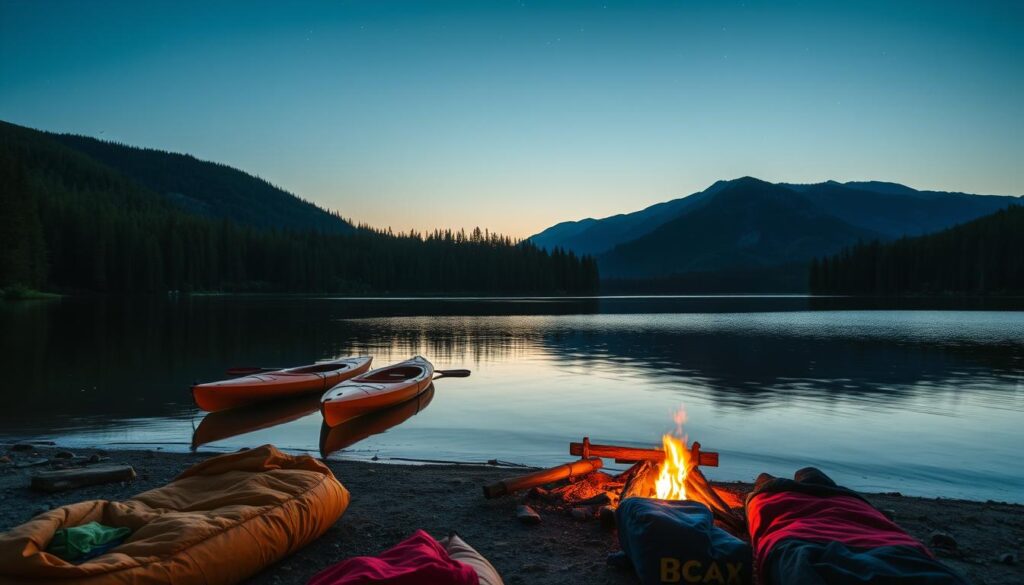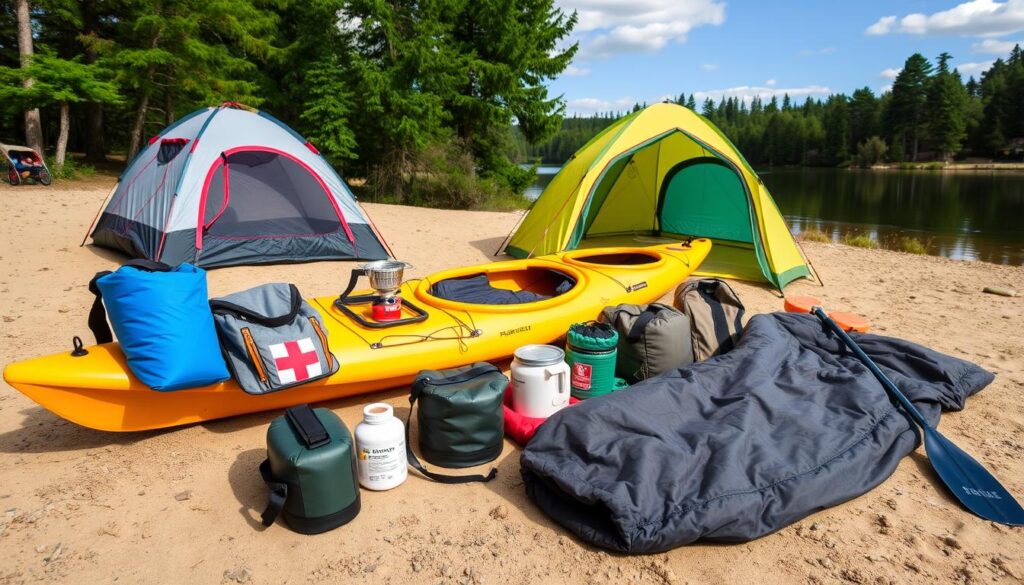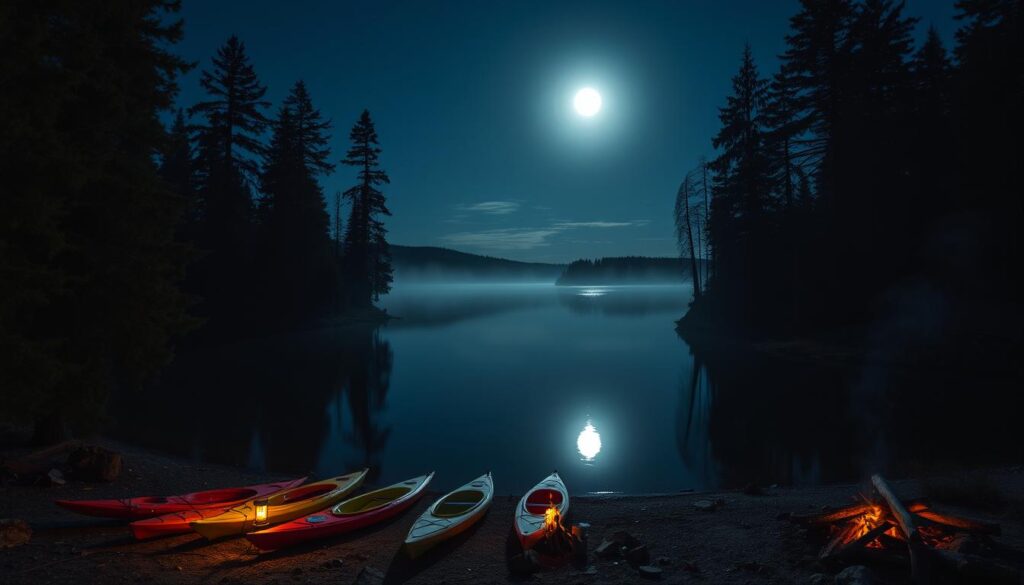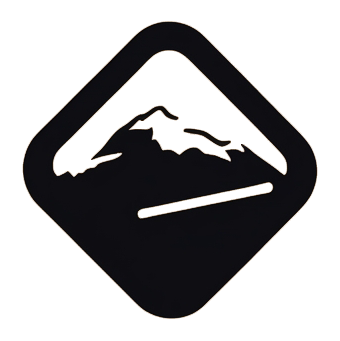Overnight kayak trips are an exciting way to see wilderness waterways and nature up close. They’re great for both experienced paddlers and those new to adventure. Planning these trips needs careful thought and strategy.

Going on overnight kayak trips means seeing stunning landscapes and testing your outdoor skills. These trips let you step away from daily life and bond with nature. Experts say planning well is key to a safe and memorable trip.
Knowing the basics of kayak camping makes any trip special. From picking the right gear to finding the best paths, every choice matters. It all adds up to an amazing wilderness adventure.
- Key Takeaways
- Essential Gear and Equipment for Overnight Kayak Adventures
- Choosing the Perfect Location for Your First Overnight Kayak Trip
- Weather Planning and Seasonal Considerations
- Meal Planning and Food Storage for Extended Kayak Trips
- Safety Protocols and Emergency Preparedness
- Navigation Skills and Route Planning for Overnight Kayak Trips
- Campsite Selection and Setup Along Water Routes
- Physical Preparation and Fitness Requirements
- Legal Requirements and Permits for Overnight Paddling
- Conclusion
- FAQ
- What fitness level do I need for an overnight kayak trip?
- How do I choose the right kayak for an overnight trip?
- What essential safety equipment should I bring?
- How do I plan meals for an overnight kayak trip?
- Are guided overnight kayak trips recommended for beginners?
- What permits do I need for an overnight kayak trip in Indiana?
- How do I protect my gear from water damage?
- What are the best seasons for overnight kayak trips in Indiana?
Key Takeaways
- Overnight kayak trips require comprehensive planning and preparation
- Safety should always be the primary consideration
- Proper gear selection is crucial for a successful trip
- Understanding your skill level helps choose appropriate routes
- Weather and seasonal conditions significantly impact trip experience
Essential Gear and Equipment for Overnight Kayak Adventures
Getting ready for overnight kayak trips means planning and the right gear. Whether you’re in Indiana’s waters or other beautiful spots, the right stuff makes a big difference. It can turn a good trip into an amazing one.

Success on overnight kayak trips comes from choosing the right gear. It should be functional, light, and durable. Here’s what you need for a great kayaking adventure.
Kayak Selection and Safety Equipment
Finding the right kayak is key for overnight trips. Think about these important things:
- Length and storage space
- How stable and easy to move it is
- How well it lasts
Always put safety first on overnight kayak trips in Indiana or elsewhere. You’ll need:
- A personal flotation device (PFD)
- A waterproof emergency whistle
- A bilge pump
- A rescue throw bag
Camping Gear Essentials
Your camping gear should be light and waterproof. Here’s what you should pack:
| Category | Essential Items |
|---|---|
| Shelter | Lightweight tent, waterproof tarp |
| Sleeping | Compact sleeping bag, inflatable sleeping pad |
| Cooking | Portable stove, compact cookware, water filtration system |
Navigation Tools and Electronics
For successful overnight kayak trips in Indiana and beyond, you need good navigation:
- Waterproof GPS device
- Detailed topographic maps
- Compass
- Waterproof smartphone case
“Preparation is the key to turning a good kayak trip into an unforgettable adventure.” – Experienced Kayaker
Make sure to test and get to know your gear before your trip. Good preparation means a safe and fun time on the water.
Choosing the Perfect Location for Your First Overnight Kayak Trip
Choosing the right spot is key for a great overnight kayak trip. Your first trip needs careful planning. This ensures a safe and unforgettable journey.

- Water conditions and difficulty level
- Scenic beauty and natural landscape
- Proximity to launching points
- Accessibility of campsites
- Local wildlife and ecological diversity
For beginners, look for calm waters and well-known routes. National parks and protected waterways are great choices for your first trip.
“The right location transforms a simple paddling journey into an extraordinary adventure.” – Kayaking Experts
Do your research on potential spots. Check out local kayaking clubs, national park websites, and outdoor recreation resources. They offer great info on water conditions, challenges, and routes.
| Location Type | Difficulty Level | Recommended for Beginners |
|---|---|---|
| Coastal Bays | Moderate | With Guided Support |
| Mountain Lakes | Easy | Highly Recommended |
| River Systems | Advanced | Not Recommended |
Guided trips are perfect for first-timers. Guides offer safety tips, help with gear, and share local secrets. This makes your trip better.
Before you go, check local rules, weather, and get any needed permits. This ensures a smooth kayaking adventure.
Weather Planning and Seasonal Considerations
Planning successful overnight kayak trips needs careful weather checking and preparation. Weather greatly affects your paddling experience, especially in Indiana’s varied landscape.
Knowing weather patterns is key for safe and fun kayaking. Each season brings its own challenges and chances for outdoor fun.
Understanding Weather Patterns
Weather can change fast on water, so being ready is vital. Important things to watch include:
- Wind speed and direction
- Temperature changes
- Chance of rain
- Possible storms
Best Seasons for Kayak Camping
Indiana is great for overnight kayak trips all year. Each season has its own benefits:
| Season | Kayaking Conditions | Recommended Preparation |
|---|---|---|
| Spring | Mild temperatures, rising water levels | Layered clothing, waterproof gear |
| Summer | Warm weather, peak kayaking season | Sun protection, hydration strategy |
| Autumn | Cooler temperatures, scenic landscapes | Thermal layers, wind-resistant clothing |
| Winter | Challenging conditions, limited opportunities | Specialized cold-water gear, expert skills |
Emergency Weather Protocols
Being ready for sudden weather changes is crucial. Always have:
- Reliable weather radio
- Emergency communication device
- Waterproof maps
- Additional shelter equipment
“Preparation is the key to turning potential weather challenges into memorable adventure experiences.” – Experienced Kayak Guide
For a successful overnight kayak trip in Indiana, you need to know the weather and be flexible. Understanding seasonal changes and being prepared helps ensure safety and fun on your water adventures.
Meal Planning and Food Storage for Extended Kayak Trips
Getting ready for overnight kayak trips means planning meals carefully. Your food plan is key to keeping you fueled and happy on the water.
For meals on the go, pick light, nutritious foods that are simple to pack and make. Dehydrated meals, energy bars, and small protein sources are great for the journey.
- Pack meals that need little cooking gear
- Go for foods that pack a lot of calories
- Use only non-perishable items
- Keep a variety to keep spirits high
Storing food on kayak trips is tricky. You’ll need waterproof, bear-resistant containers to keep your food safe from water and animals.
| Food Type | Storage Method | Recommended Quantity |
|---|---|---|
| Dried Meals | Sealed Ziplock Bags | 1-2 portions per meal |
| Protein Bars | Waterproof Container | 2-3 per day |
| Trail Mix | Airtight Packaging | 1 cup daily |
“Proper meal planning transforms a challenging kayak trip into an enjoyable wilderness experience.” – Experienced Kayak Guide
Don’t forget to pack the essentials for cooking, like a small stove, light utensils, and water purification tools. Your food plan should be about nutrition, weight, and ease for a great kayak trip.
Safety Protocols and Emergency Preparedness
Keeping safe on overnight kayak trips is key for a fun and safe adventure. Guided trips teach you important safety skills. This helps you enjoy beautiful waterways without worry.
Being ready can change a good trip into a bad one. Knowing safety rules helps you face challenges on your kayaking journey.
First Aid and Emergency Communication
Having a good first aid kit is a must for overnight trips. Your kit should have:
- Waterproof first aid supplies
- Emergency communication device
- Satellite phone or emergency beacon
- Whistle for signaling
- Waterproof matches
Water Safety Guidelines
Knowing how to stay safe in the water is crucial. Important tips include:
- Always wear a properly fitted life jacket
- Learn self-rescue and group rescue techniques
- Practice capsize recovery before your trip
- Stay aware of weather conditions
Risk Assessment Strategies
| Risk Factor | Mitigation Strategy |
|---|---|
| Weather Changes | Check forecasts, carry weather radio |
| Physical Fitness | Train beforehand, know personal limits |
| Navigation | Carry GPS, maps, compass |
| Group Safety | Establish communication protocols |
“Preparation is the key to safe and enjoyable outdoor adventures.” – Wilderness Safety Expert
By following these safety tips, you’ll be ready for any challenge on your overnight kayak trips. This ensures a safe and unforgettable experience.
Navigation Skills and Route Planning for Overnight Kayak Trips
Mastering navigation skills is key for a great overnight kayak trip. Indiana’s waterways are diverse, and knowing how to read maps and plan routes is essential. It can turn a trip into an adventure or a tough journey.
To prepare for overnight kayak trips, you need to learn several important navigation techniques:
- Learn to read topographical water maps
- Identify potential water hazards
- Estimate realistic travel distances
When planning an overnight kayak trip in Indiana, focus on the local waterways. Rivers like the White River and Ohio River have unique challenges. You’ll need to plan carefully.
“Preparation is the key to safe and enjoyable kayaking adventures.” – Expert Kayak Guide
Some critical navigation skills include:
| Skill | Importance | Practice Method |
|---|---|---|
| Map Reading | Essential | Practice with local trail maps |
| Current Understanding | Critical | Study river flow rates |
| Distance Estimation | Vital | Use GPS tracking |
Before you go on an overnight kayak trip, spend time learning these skills. Start with shorter trips to get better at navigation. This will help you feel more confident and skilled on Indiana’s waterways.
Campsite Selection and Setup Along Water Routes
Planning the perfect campsite for overnight kayak trips is key. You need to find a spot that’s safe, comfy, and good for the environment.
Waterfront Camping Techniques
When picking a campsite, think about the terrain and how protected it is. Look for spots that:
- Are higher up to avoid water level changes
- Have natural barriers like rocks or trees
- Give you a clear view of the area
- Have flat ground for your tent
Leave No Trace Principles
Responsible kayak camping means not harming the environment. Here are some key rules:
- Camp on surfaces that can handle it
- Take all trash with you
- Don’t disturb wildlife
- Use existing campsites if you can
Site Security Methods
To keep your gear safe and have a great trip, use these security tips:
| Security Method | Description |
|---|---|
| Gear Storage | Use waterproof bags and keep kayaks high and dry |
| Wildlife Protection | Keep food in sealed containers away from where you sleep |
| Perimeter Check | Check your campsite for dangers before setting up |
“The perfect campsite turns a regular kayak trip into an amazing adventure.” – Professional Kayak Guide
Remember, finding the right campsite for overnight kayak trips takes practice and paying attention to your surroundings.
Physical Preparation and Fitness Requirements
Getting ready for overnight kayak trips is more than just wanting to go. Your physical shape is key to a safe and fun trip. Paddlers who do well know that being strong, enduring, and flexible are important.
To do well on overnight kayak trips, work on specific muscles and heart health. Your training should aim at:
- Upper body strength (shoulders, arms, back)
- Core muscle stability
- Cardiovascular endurance
- Flexibility and range of motion
“The water doesn’t care about your fitness level – you must be prepared before you launch.” – Professional Kayak Instructor
A good fitness plan for overnight kayak trips should include:
- Strength training with resistance bands
- Paddling-specific exercises
- Cardiovascular workouts like swimming and cycling
- Yoga or stretching for improved flexibility
What you eat is also important for kayaking adventures. Eat balanced meals with lean proteins, complex carbs, and healthy fats. Drinking lots of water is also key to stay at your best.
Think about getting help from a fitness expert who knows about kayaking. They can make a plan just for you. This plan will help you get strong and last long on tough overnight kayak trips.
Legal Requirements and Permits for Overnight Paddling
Planning overnight kayak trips means knowing the law and local rules. It might seem hard to understand paddling permits. But, knowing the rules makes your trip better.
Before you go on your overnight kayak trip in Indiana, learn the state and local laws. Each waterway has its own rules that can change your trip.
State-Specific Regulations
Every state has its own rules for overnight kayak trips. Indiana, for example, has its own set of rules for paddlers:
- Get the right watercraft registrations
- Check if you need local conservation area permits
- Know the rules for waterway access
Protected Waters Guidelines
Know about protected water areas when planning your kayak camping trip. National and state parks have strict rules for overnight paddling.
| Water Type | Permit Required | Additional Requirements |
|---|---|---|
| State Parks | Yes | Camping reservation |
| National Wildlife Refuges | Yes | Special use permit |
| Public Waterways | Limited | Local registration |
Required Documentation
Make sure you have these important documents for your overnight kayak trips:
- Valid state watercraft registration
- Personal identification
- Camping permits
- Emergency contact information
“Knowing local laws is key for a safe and legal paddling adventure.” – National Kayaking Association
Pro tip: Always check with local authorities and park services before your trip to confirm the most current regulations for overnight kayak trips.
Conclusion
Overnight kayak trips are a great way to see the world from a different view. By getting ready and knowing the key skills, your trip can be amazing. Whether you’re new or have experience, start small and grow your confidence.
Safety and planning are key for a good trip. Each trip is a chance to learn, connect with nature, and make memories. Begin with easy routes, good gear, and learn important skills. Guided trips are great for learning from experts.
The wilderness is ready for you. Your kayak opens doors to beautiful places and personal growth. As you get better, you’ll love the freedom and adventure of these trips. Always respect nature, stay safe, and enjoy learning.
Your kayaking adventure begins today. Get your stuff ready, plan well, and make memories that will last forever. The water is calling, and an amazing journey is waiting for you.
FAQ
What fitness level do I need for an overnight kayak trip?
You need a moderate fitness level for an overnight kayak trip. Good upper body strength and heart health are key. You don’t have to be an athlete, but regular paddling and core exercises help.
If you’re new, start with short trips. Then, you can build up your endurance for longer journeys.
How do I choose the right kayak for an overnight trip?
Choose a touring or sea kayak for its storage and stability. Look at length, weight capacity, and storage. Sit-inside kayaks are best for overnight trips because they offer more storage and protection.
What essential safety equipment should I bring?
Your safety kit should have a Coast Guard-approved life jacket and a first aid kit. Also, bring an emergency communication device, whistle, headlamp, spare paddle, bilge pump, and basic tools. Always check and maintain your gear before each trip.
How do I plan meals for an overnight kayak trip?
Choose lightweight, non-perishable, and high-energy foods like dried meals and energy bars. Use waterproof containers and a compact camping stove. Plan meals that are easy to prepare and give enough calories for paddling and camping.
Are guided overnight kayak trips recommended for beginners?
Yes, guided trips are great for beginners. They offer professional instruction, safety, and route planning. Guides also share kayaking tips and help with gear and emergency plans.
What permits do I need for an overnight kayak trip in Indiana?
Permits vary by route and camping location. You might need state park permits, river access permits, or local passes. Always check with Indiana Department of Natural Resources and local authorities for specific requirements.
How do I protect my gear from water damage?
Use waterproof dry bags for electronics, clothes, and important items. Choose bags of different sizes and color-code them. Use waterproof cases for phones and other electronics. Consider kayak-specific dry bags for efficient storage.
What are the best seasons for overnight kayak trips in Indiana?
Late spring (May-June) and early fall (September-October) are the best seasons. They offer comfortable temperatures, low humidity, and stable weather. Always check local weather and water conditions before your trip.

